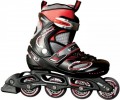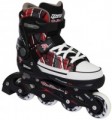Size
—
Fixed size. Boots of the simplest design, having one size and not allowing for adjustment in length. In addition to the obvious disadvantage of the impossibility of adjusting to size, this design also has an advantage - it is considered more durable and reliable than an adjustable one, and if selected correctly, it sits “firmer” on the foot, which makes such boots more suitable for performing various tricks. In general, rollers with a fixed size are suitable either for an adult user whose leg is no longer growing, or for a child, if we are talking about a pair for one season.
—
Adjustable size. Boots that allow you to adjust the size within a certain range - usually within 3 - 5 sizes, for example 36 - 39 or 28 - 32. The advantages of this option are obvious: it allows you to optimally adjust the boot to your foot size, one pair of rollers can be used in turn by different people, and for rollers bought for a growing child, the adjustable size is simply a salvation: without this, the rollers would have to be changed every year. On the other hand, adjustment complicates the design of the boot and reduces its strength, so this design is not widespread in professional models (“aggressive”, running, etc.).
The size itself is given according to standard shoe sizes. At the same time, the listing of sizes - for example, “
39,
40..., 41 ” - means that the rollers are available in several modifications with a fixed size; and a hyphenated record like “39 – 41” corresponds to one shoe with an adjustable size.
Note that formal compliance with the foot size does not necessarily mean that the rollers will suit a particular user. Firstly, human legs have individual shapes, and a model that is normal in length may, for example, turn out to be cramped in the instep. Secondly, some manufacturers can be quite liberal with sizes, especially when it comes to budget models. Therefore, when choosing, it is recommended not to rely on the stated figures, but to check the comfort of the boot “live” (or at least clarify how the stated dimensions correspond to the actual ones), especially for children’s skates.
Currently the following roller sizes are available on the market: 25, 26, 27, 28, 29, 30, 31, 32, 33, 34, 35, 36, 37, 38, 39, 40, 41, 42, 43, 44, 45, 46, 47.Wheel size
The diameter of the wheels supplied with roller skates.
This parameter is usually selected by the manufacturer based on the style of riding for which the rollers are designed (see above). The general rule is this: the
larger the diameter, the more “high-speed” the wheels are considered and the less sensitive they are when hitting bumps. Wheels with a diameter of about 76 – 82 mm are considered universal, these are the sizes that are found in most fitness roller skates and stunt models (see "Riding style"). In running equipment, this size can be noticeably larger — this is done to ensure a fast and smooth ride. But on the "aggressive" models, the wheels, on the contrary, are small — with this driving style, it is critical to feel all the bumps under the rollers.
Boot type
The type of boot provided in the design of roller skates.
—
Soft. Such boots are similar in design to high sports shoes made of soft materials, reinforced where necessary with hard materials (most often plastic). Such shoes comfortably and tightly sit on the foot, provide good ventilation, and are light in weight. Of its practical shortcomings, one can only note a slightly lower strength than that of hard boots. However, it can become noticeable only in difficult driving modes, with an abundance of loads (primarily side loads). In addition, the soft part of the boot is not always removable, which can complicate its cleaning. In light of all this, soft boots are very popular in all types and price categories of modern roller skates — except that in "
aggressive " models (see "Riding style") they usually have a soft part only on top and at first glance do not differ much from hard ones.
—
Hard. Boots are made entirely of solid materials and equipped with a soft insert for comfortable placement of the foot inside. Historically, this is the first type of roller skate boot, but today it is much less common than the soft variety. This is due to several inconveniences: hard boots are less ventilated, weigh more, and also require increased attention to the choice — the slightest mismatch in the shape of the foot can cause serious discomfort. However, they have
...high strength and resistance to lateral loads. Therefore, hard boots are still used in some models of inline skates — both for fitness and for stunt riding (see "Riding style").Boot material
The main material used in the design of the boot. Note that this material is not the only one: soft varieties of shoes (see “Shoe type”) are necessarily complemented by a rigid frame; hard ones, on the contrary, with a soft insert. However, the features of the boot depend primarily on the base material.
— Nylon. The soft material used in roller skates with the appropriate type of boot. This material is very popular in sports shoes in general and roller skates in particular: it is inexpensive, durable enough, and can be of any colour, and there are many varieties of nylon on the market, including those with rather advanced features. Thanks to all this, nylon is today, in fact, the main material for soft boots of all levels, from the simplest to the professional.
— Faux leather. Material that imitates the appearance of genuine leather. Like nylon, it is used for soft boots and has many varieties that vary in quality. However, for several reasons, the use of faux leather is typical mainly for fairly advanced skates, including
running models, and the quality of this material is quite consistent with the class of equipment.
— Microfibre. Another option is found in soft varieties of boots. Microfibre is based on polymer synthetic threads of extremely small thickness, due to which this material has several useful features. In particular, it retains heat well and at the same time provides moisture removal, allowing
...the skin to "breathe", while it dries quickly, and is easy to clean and wash. At the same time, microfibre is not cheap. As a result of all this, it is a professional sports material and is found in models of the appropriate level (and even then quite rarely).
— Plastic. This material is the same material for hard roller skate boots as nylon is for soft ones. It is characterized by a combination of low cost with an abundance of colours and good durability characteristics. It is also available in many grades, among which you can choose an option for almost any occasion — from inexpensive children's skates to durable professional models. And the fact that plastic shoes are rare is not due to the characteristics of plastic, but to the low prevalence of hard shoes in general.
— Carbon fibre. Material based on elongated carbon fibre filaments. It is used in hard boots and is considered very advanced: at a lower weight than plastic, carbon fibre has an extremely high strength, comparable to the characteristics of steel. At the same time, in roller skates, even professional ones, such strength is rarely required, and boots made of this material are not cheap. Therefore, carbon fibre is not widely used.Detachable frame
The presence
of a detachable frame in the design of roller skates.
The main meaning of this feature lies in the ease of repair: if the frame breaks, it is enough to replace only it without changing the entire skate with the boot. In addition, if desired, you can change completely serviceable frames for others — for example, more durable and resilient. Of course, for this you need to find a suitable option for the size of the mounts, but for this size there is a single UFS standard, which is gradually becoming more and more popular. Also, the detachable frame makes it easier to clean and wash soft boots (see "Boot type").
The main disadvantage of such roller slates is the tendency of the fasteners to loosen during riding. However, it is quite simple to protect yourself from the troubles associated with this — just check and, if necessary, tighten the mounting bolts before each ride.

